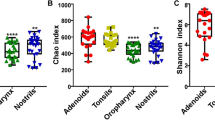Abstract
To determine normal proportions of pharyngealHaemophilus species, qualitative and quantitative mapping of the species in the pharynx of ten healthy children and ten healthy adults was carried out using a selective and a non-selective medium.Haemophilus organisms were present in all samples, comprising approximately 10 % of the total cultivable flora (range 0.6–36.9 %).Haemophilus parainfluenzae was a member of the normal flora throughout life, constituting 74% of pharyngealHaemophilus organisms.Haemophilus segnis andHaemophilus paraphrophilus occurred more frequently in samples from adults, whereasHaemophilus haemolyticus was present in only one sample. Non-encapsulatedHaemophilus influenzae strains, usually of multiple biotypes, were present in 80% of the children but accounted for a mean of only 1.8 % of the total flora. Their number decreased with increasing age; 40 % of the adults harboredHaemophilus influenzae but only of a single biotype which constituted a minor proportion of the total flora (mean 0.15%). These findings suggest that host mechanisms can influence changes in the proportions ofHaemophilus influenzae strains colonizing the host.
Similar content being viewed by others
References
Hovig, B., Aandahl, E. H.: A selective method for the isolation ofHaemophilus in material from the respiratory tract. Acta Pathologica et Microbiologica Scandinavica 1969, 77: 676–784.
Sims, W.: Oral haemophili. Journal of Medical Microbiology 1970, 3: 615–625.
Kilian, M., Heine-Jensen, J., Bülow, P.:Haemophilus in the upper respiratory tract of children. A bacteriological, serological and clinical investigation. Acta Pathologica et Microbiologica Scandinavica, (B) 1972, 80: 571–578.
Kilian, M., Schiött, C. R.: Haemophili and related bacteria in the human oral cavity. Archives of Oral Biology 1975, 20: 791–796.
Turk, D. C., May, J. R.:Haemophilus influenzae: its clinical significance. English Universities Press, London, 1967.
Long, S. S., Henretig, F. M., Teter, M. J., McGowan, K. L.: Nasopharyngeal flora and acute otitis media. Infection and Immunity 1983, 41: 987–991.
Jensen, S. B., Löe, H., Schiött, C. R., Theilade, E.: Experimental gingivitis in man. Journal of Periodontal Research 1968, 3: 284–293.
Kilian, M.: A taxonomic study of the genusHaemophilus, with the proposal of a new species. Journal of General Microbiology 1976, 93: 9–62.
Gratten, M.:Haemophilus influenzae biotype VII. Journal of Clinical Microbiology 1983, 18: 1015–1016.
Barenkamp, S. J., Munson, R. S., Granoff, D. M.: Outer membrane protein and biotype analysis of pathogenic nontypableHaemophilus influenzae. Infection and Immunity 1982, 36: 535–540.
Pittman, M.: Variation and type specificity in the bacterial speciesHaemophilus influenzae. Journal of Experimental Medicine 1931, 53: 471–493.
Kilian, M., Thomsen, B.: Antigenic heterogeneity of immunoglobulin Al proteases from encapsulated and non-encapsulatedHaemophilus influenzae. Infection and Immunity 1983, 42: 126–132.
Kamme, C., Lundgren, K., Mårdh, P. -A.: The aetiology of acute otitis media in children. Scandinavian Journal of Infectious Diseases 1971, 3: 217–223.
Freijd, A., Bygdeman, S., Rynell-Dagöö, B.: The nasopharyngeal microflora of otitis-prone children, with emphasis onHaemophilus influenzae. Acta otolaryngologica 1984, 97: 117–126.
Gray, B. M., Converse III, G. M., Dillon, H. C.: Epidemiologic studies ofStreptococcus pneumoniae in infants: acquisition, carriage, and infection during the first 24 months of life. Journal of Infectious Diseases 1980, 142: 923–933.
Gray, B. M.: Sulfa-trimethoprim prophylaxis and the natural history of recurrent otitis media. Pediatric Research 1981, 15: 612–618.
Henderson, F. W., Collier, A. M., Sanyal, M. A., Watkins, J. M., Fairclough, D. L., Clyde, W. A., Denny, F. W.: A longitudinal study of respiratory viruses and bacteria in the etiology of acute otitis media with effusion. New England Journal of Medicine 1982, 306: 1377–1383.
Kilian, M., Reinholdt, J., Mortensen, S. B., Sørensen, C. H.: Perturbation of mucosal defence mechanisms by bacterial IgA proteases. Bulletin European de Physiopathologie Respiratoire 1983, 19: 99–104.
Author information
Authors and Affiliations
Rights and permissions
About this article
Cite this article
Kuklinska, D., Kilian, M. Relative proportions ofHaemophilus species in the throat of healthy children and adults. Eur. J, Clin. Microbiol. 3, 249–252 (1984). https://doi.org/10.1007/BF02014895
Issue Date:
DOI: https://doi.org/10.1007/BF02014895




